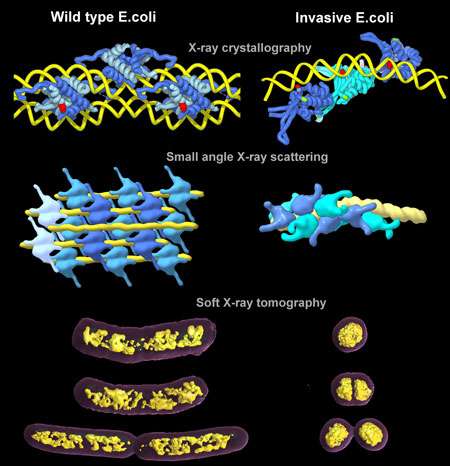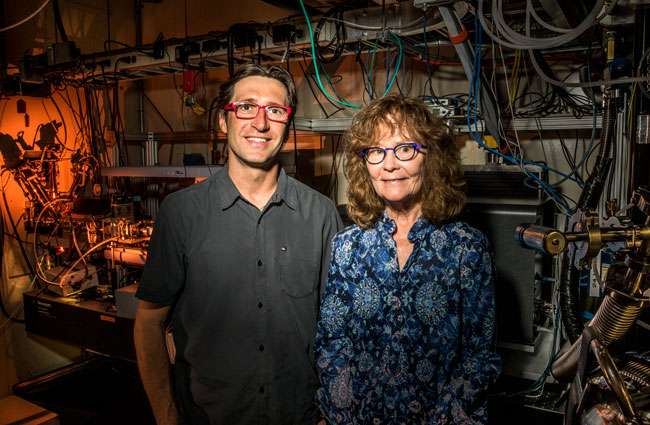Researchers find molecular switch that triggers bacterial pathogenicity

Scientists have revealed for the first time the molecular steps that turn on bacteria's pathogenic genes. Using an array of high-powered X-ray imaging techniques, the researchers at the Department of Energy's Lawrence Berkeley National Laboratory (Berkeley Lab) showed that histone-like proteins that bind to DNA are related to the physical twisting of the genetic strand, and that the supercoiling of the chromosome can trigger the expression of genes that make a microbe invasive.
The study, to be published July 29 in the journal Science Advances, could open up new avenues in the development of drugs to prevent or treat bacterial infection, the study authors said.
The researchers looked at how the long strands of DNA are wound tight, a necessity if they are to fit into compact spaces. For eukaryotes, the strands wrap around histone proteins to fit inside a nucleus. For single-celled prokaryotes, which include bacteria, HU proteins serve as the histones, and the chromosomes bunch up in the nucleoid, which lacks a membrane.
When the normal twists and turns of DNA compaction turn into supercoiling, trouble can begin.
"It has been known that DNA supercoiling leads to pathogenicity in bacteria, but exactly how the bacterial chromosome is condensed, organized, and ultimately segregated has been a puzzle for over half a century," said study lead author Michal Hammel, research scientist in Berkeley Lab's Molecular Biophysics and Integrated Bioimaging Division. "What we did for the first time was to visualize in E. coli how this packing is done, and we also discovered that the way HU proteins pack the chromosomes can trigger gene expression. That is new."
Capturing HU in action
Elucidating these molecular mechanisms entailed imaging HU proteins at different resolutions and stages using two beamlines at Berkeley Lab's Advanced Light Source, a DOE Office of Science User Facility. The SIBYLS (Structurally Integrated Biology for Life Sciences) beamline, directed by senior scientist John Tainer, combines X-ray crystallography and small angle X-ray scattering (SAXS) capabilities. The crystallography provided atomic-level details of how the HU proteins interacted with the bacterial DNA, while SAXS was able to show how the HU proteins assembled and affected the longer strands of DNA in a solution.

To get a clear sense of how that twisting and packing manifests at the cellular level, Hammel teamed up with Berkeley Lab faculty scientist Carolyn Larabell, director of the National Center for X-ray Tomography (NCXT), also based at the Advanced Light Source.
"We needed the interaction of these different techniques to get the overall picture of how the HU interactions with DNA were affecting the bacteria," added Larabell, who is also a professor of anatomy at UC San Francisco. "With X-ray tomography, we're able to see the natural contrast in organic material in as close to a living state as possible, and we can provide quantitative comparisons of how compacted the chromosomes were in pathogenic and normal strains of E. coli."
Larabell calculated that the genetic material in the pathogenic E. coli is so tightly packed that it consumes less than one-half the volume compared with its non-mutant counterpart.
A target to control pathogenesis
Before this paper, it had been believed that the enzyme topoisomerase was the primary driver of DNA coiling in bacteria. This new study shows that, independent of topoisomerase, changing the assembly of HU proteins was enough to induce changes in DNA coiling at different stages of bacterial growth.
"What is notable about HU proteins as a trigger for gene expression is that it's quick," said Hammel. "This makes sense as a survival mechanism for bacteria, which need to adapt quickly to different environments."
The study results also beg the question: If pathogenicity can be switched on, could it also be switched off?
"We certainly expect to answer that question in future studies," said Hammel. "These HU interactions could be an attractive target for drugs that control pathogenesis, not only of bacteria, but of other microbes with comparable genetic structures."
More information: "HU multimerization shift controls nucleoid compaction" Science Advances, advances.sciencemag.org/content/2/7/e1600650
Journal information: Science Advances
Provided by Lawrence Berkeley National Laboratory




















